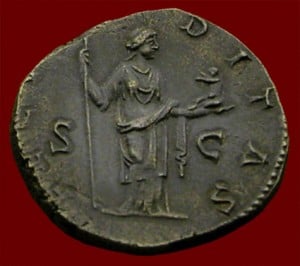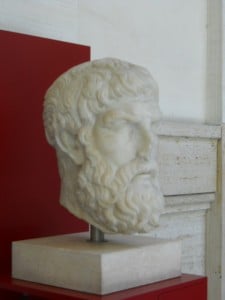The next step in preparing for formal ritual is to gather together the implements that may be needed. These may depend on the God or Goddess for whom you intend to call upon. For example, iron and steel implements are never to be brought into a place dedicated to Ceres; bronze, brass, or copper implements are used in Her rites instead. However, iron is appropriate to use in rites for Mars. No leather may be worn or used in rites for Carmenta, or for any other Goddess concerned with childbirth.

Here is a display of some of my implements. In the top background are to brass goblets with glass insets. In front of these is a bronze tray on which are set two terra cotta, Roman style oil lamps. Moving clockwise from the lamps is a bowl of herbal offerings. These include bay laurel leaves from my tree, as well as roses and poppy heads grown on my property. They therefore represent produce of my land which I offer back to the Gods.

Next in order are a couple of small brass bowls, and a patera that was made for me by a nephew. A patera is a kind of shallow bowl, much as is used to serve sake, which is used to pour libations of wine. A Roman patera was usually made of bronze and had a knob in the center on which to rest the thumb while pouring a libation. This was to aid in preventing the human hand to touch the wine after it was dedicated. (A Greek patera had a handle instead.) Also seen in the top photo, arching along the center bottom, are bowls of wheat in various stages of preparation as mola salsa. This preparation of wheat and salt is essential in all Roman rituals – a subject to which I shall return later.

Continuing around in the top photo is then white ceramic type of patera with a stem, together with a matching plate to cover its contents. At the bottom center then are a number of implements made of bronze and/or wood. These are a bronze stylus made by Livia Plauta, a bronze probe with a brass filigree ball at one end, a two-sided spatula given to me by my father, a wooden handled probe with copper wire forming a loop at one end and a hook at the other, and then a ten inch needle (16 cm) and a wrought probe of similar length.
Continuing further around, on the left of the brass tray above is a carved wooden box, the acerra, which holds incense. In front of it is a brass censer that I have used in ritual for over forty years.
At the center of the brass tray is a handmade bronze sacrificial knife that is essential for Roman ritual. No matter what food-stuff is offered, it is properly cut first and scooped up on the knife for placing into the altar fire. Once dedicated, the offering may not be touched, so it takes some practice to handle a sacrificial knife with one hand alone and not drop an offering before placing it on the altar. An alternative method allows the celebrant to use a mappa, a cloth napkin, with which to balance an offering on the sacrificial blade without profaning the offering.
Many cultores Deorum Romani employ ancient artifacts as relics that hold the numina of ancient Romans. These might be stones or pottery shards from significant sites, ancient bronze statues, Roman glass or bronze vessels, and most often Roman coins. In the picture above, to the upper left of the sacrificial blade, may be seen a number of bronze and silver Roman coins, dating from different eras and from different provinces, all acquired as gifts from other cultores Deorum. Thus attached to them are special memories of friends, as well as their energies and the numina of all those ancient Romans through whose hands they were exchanged.
Implements used in ritual are to be kept separate from all other tools and implements. They are never to be used for any purpose other than ritual and are thus always handled as holy objects. Since there are many different types of rituals in the Religio Romana, a cultor Deorum Romani might acquire an assortment of implements. Ritual implements can be purchased for the purpose of ritual, or else made yourself for the purpose. I generally prefer to receive them as gifts from co-religionists and family members. This lends them an added dimension, a special memory attached to them, and the numina of the friends who gave them. Ritual implements should be stored separately – I hold some of mine in a cedar chest that was formerly my mother’s, and others in a oak shrine built by my father. Cedar is the tree of Juno, while oak is a tree of Jupiter. Prior to formal ritual, the implements selected for use are to be cleansed in ritual fashion, anointed and incensed. This can be a preliminary ritual in itself, as the numina contained within the implements would be called upon to lend their assistance in the rituals. Passed on from one generation to another, the ritual implements would hold the numina of your family members, your Lares who are invoked to guide you in your rites, as well as the numina of the Goddesses and Gods they have served in the past. Ritual is a means by which we interact with the Gods and Goddesses of ancient Rome. Ritual implements are but one means for conducting ritual. Their continued use and long exposure to our ancestors and the Gods, infusing them with Their presence during ritual, is what makes ritual implements holy objects.
















